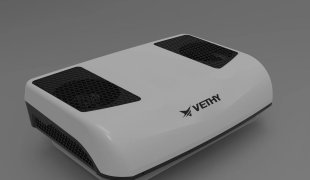Maximizing Comfort on the Road: Choosing the Right 10,000 BTU AC for Your Truck Cab
February 13, 2025
Introduction to the Importance of Truck Cab Comfort
The Impact of Temperature on Driver Well-being
Comfort is an essential, not a luxury, when it comes to long-haul trucking. Drivers travel through a variety of weather circumstances for endless hours. Fatigue, poor focus, and even health problems may arise from extreme temperatures. Maintaining safe driving behaviors and preserving consciousness require a comfortable cab environment.
The Role of Air Conditioning in Enhancing Comfort
In this case, having a reliable air conditioning system is helpful. A 10,000 BTU air conditioner can effectively cool truck cabs, enabling drivers to maintain a pleasant environment regardless of the outside temperature. The performance and general well-being of a driver can be enhanced by investing in a high-quality air conditioner.
Understanding Air Conditioning Units for Trucks
How Truck AC Units Differ from Standard Units
Truck AC units are made especially to satisfy the special requirements of commercial vehicles. Truck air conditioners must be able to endure the severe realities of life on the road while still providing effective cooling, unlike typical household or portable air conditioners. They are designed to be more robust and frequently include features that address the distinctive requirements of truck cabins.
The Significance of BTU in Air Conditioning
The British Thermal Unit, or BTU, is a metric used to measure an air conditioner's cooling capacity. When choosing an air conditioner for your truck cab, it is essential to understand BTUs. More cooling capacity is shown by a greater BTU rating, but higher energy use is also a result. Finding a balance that satisfies your cooling requirements without using a great deal of energy is therefore crucial.
The Specifics of a 10,000 BTU AC Unit
What 10,000 BTU Means in Real Terms
An air conditioner with 10,000 BTU can effectively chill an area of around 400 square feet. Because of this, it is suitable for most truck cabs, which are typically between 100 and 200 square feet in size. However, its performance may be impacted by elements like insulation and ambient temperatures.
The Science Behind Cooling Capacity
A fundamental aspect of the science behind cooling capacity is comprehending how air conditioners remove heat from a space. With a 10,000 BTU unit, the truck cab can lose 10,000 BTUs of heat every hour. This cooling procedure involves the circulation of refrigerant, which absorbs heat from the interior and releases it outdoors.
Assessing Your Cooling Needs
Factors about Truck Cab Temperature
Several factors influence the temperature inside a truck cab:
· External Weather Conditions: Hot weather can significantly raise cabin temperatures.
· Cab Insulation: Well-insulated cabs retain cool air better than poorly insulated ones.
· Sun Exposure: Direct sunlight can increase internal temperatures rapidly.
Understanding these factors will help you assess your specific cooling needs and choose the right AC unit accordingly.
Calculating the Right BTU for Your Cab
To determine whether a 10,000 BTU unit is suitable for your truck cab, consider conducting a simple calculation:
1. Measure your cab's square footage.
2. Factor in insulation quality and sun exposure.
3. Use this information to decide if additional cooling capacity is needed.
If your cab is particularly large or poorly insulated, you may want to consider a higher BTU rating.
Energy Efficiency of 10,000 BTU AC Units
Understanding EER and SEER Ratings
Energy efficiency is crucial for minimizing operational costs associated with running an air conditioning unit. Two important metrics to consider are:
· EER (Energy Efficiency Ratio): This measures how efficiently an AC unit operates at peak load conditions.
· SEER (Seasonal Energy Efficiency Ratio): This measures efficiency over an entire cooling season.
Higher EER and SEER ratings indicate greater energy efficiency, which translates into lower energy bills.
How Efficiency Translates to Cost Savings
Over time, purchasing an energy-efficient 10,000 BTU air conditioner can result in significant expense savings. In addition to saving money on fuel, cutting back on operating energy will also lessen your carbon impact and help create a more sustainable world.
Types of 10,000 BTU AC Units Available
Window vs. Portable vs. Rooftop Systems
When choosing an air conditioning unit for your truck cab, consider the different types available:
· Window Units: These are typically mounted in a window opening and offer easy installation but may obstruct views.
· Portable Units: These can be moved between vehicles or locations but may require additional setup.
· Rooftop Systems: Permanently installed on the roof of the vehicle; they provide unobstructed airflow but require more complex installation.
Each type has its pros and cons; understanding these will help you make an informed decision based on your specific needs.
Split and Single Unit Systems
Split systems consist of two separate units—one inside and one outside—allowing for quieter operation inside the cab. Single-unit systems are compact and easier to install but may generate more noise within the cabin. Consider your preferences regarding noise levels when choosing between these options.
Installation Considerations for Truck ACs
DIY vs. Professional Installation
If you have some basic electrical knowledge, you can install a parked air conditioner yourself, but hiring professionals guarantees safety and legal compliance. Experts are also able to offer warranties for their labor.
Tools and Skills Needed for Installation
If you choose to install the unit yourself, make sure you have the necessary tools:
· Screwdrivers
· Wrenches
· Drill
· Electrical tape
· Wire connectors
Basic knowledge of electrical systems will also be beneficial during installation.
Maintenance and Longevity of Your AC Unit
Routine Checks and Preventive Maintenance
Regular maintenance ensures that your portable AC functions efficiently throughout its lifespan:
1. Clean Filters: Regularly clean or replace filters to maintain airflow.
2. Inspect Components: Check electrical connections and refrigerant levels periodically.
Extending the Life of Your AC with Proper Care
Proper care can significantly extend the life of your unit:
· Store it properly during off-seasons.
· Keep it clean from dust and debris.
· Address any issues immediately before they escalate.
Cost Analysis of 10,000 BTU AC Units
Initial Costs vs. Long-Term Savings
Buying a high-quality parked air conditioner may require an upfront expenditure, but think about how it will save you money over time by using less fuel and producing lower energy costs.
Operational Costs and Energy Bills
Evaluate ongoing operating costs related to energy consumption; efficient models may yield significant savings over time compared against less efficient alternatives available today!
Environmental Impact of Truck ACs
The Role of Refrigerants in Environmental Footprint
The kind of refrigerant your PAC uses can have a big impact on the environment. In the past, a lot of refrigerants, such chlorofluorocarbons (CFCs), were ozone-depleting substances (ODS). Manufacturers, however, are now using ozone-friendly substitutes that contribute less to global warming.
Choosing Eco-Friendly Options
Eco-friendly choices that employ low-GWP refrigerants and energy-efficient technologies to reduce environmental impact while maintaining effective cooling should be taken into consideration when choosing a parking air conditioner.
Safety Features in Truck AC Units
Compliance with Electrical Safety Standards
Safety should always be top-of-mind when installing any electrical appliance within vehicles! Look out for built-in safety features such as:
· Overheat protection
· Automatic shut-off mechanisms
· Circuit breakers
Protecting Your Investment and Health
Ensuring safety features are present protects both users’ health/safety while ensuring legal compliance within industry standards!
The User Experience with 10,000 BTU ACs
Real-World Performance in Various Conditions
User feedback provides valuable insights into how well products perform under real-world conditions! Many travelers report significant improvements after using portable PACs during trips—highlighting benefits experienced firsthand while on long journeys!
Feedback from Professional Truck Drivers
Professional drivers often share their experiences regarding increased comfort levels achieved through these systems—highlighting their importance within modern travel operations!
Versatility Across Different Truck Models
Compatibility with Different Makes and Models
Not all parking AC units fit every vehicle type; it's crucial to ensure compatibility with your specific make and model. Some manufacturers offer universal fitment solutions or custom installations tailored to unique vehicles.
Custom Solutions for Unique Truck Cabs
For specialized vehicles or custom builds, look for manufacturers that offer tailored solutions designed specifically for unique cab configurations—ensuring optimal performance!
Future Trends in Truck AC Technology
Emerging Technologies for Enhanced Comfort
As technology continues advancing rapidly—we anticipate exciting developments within industry including smarter/greener solutions tailored specifically towards user needs!
The Impact of Temperature on Driver Well-being
Comfort is a need, not a luxury, when it comes to long-haul trucking. Drivers navigate through a variety of weather situations for endless hours. Fatigue, poor focus, and even health problems can result from extreme temperatures. Ensuring safe driving behaviors and preserving awareness require a comfortable cab environment.
The Role of Air Conditioning in Enhancing Comfort
In this case, having a reliable air conditioning system is helpful. A 10,000 BTU air conditioner can effectively cool truck cabs, enabling drivers to maintain a comfortable environment regardless of the outside temperature. The performance and general well-being of a driver can be enhanced by investing in a high-quality air conditioner.
Understanding Air Conditioning Units for Trucks
How Truck AC Units Differ from Standard Units
Truck cooling systems are made especially to satisfy the special requirements of commercial vehicles. Truck air conditioners must be able to endure the extremes of life on the road while still providing effective cooling, unlike typical household or portable air conditioners. They are designed to be more robust and frequently include features that address the distinctive requirements of truck cabins.
The Significance of BTU in Air Conditioning
The cooling capability of an air conditioner is measured in British Thermal Units, or BTUs. It is critical to comprehend BTUs while selecting an air conditioner for your truckcab. A higher BTU rating indicates more cooling capacity, but it also means more energy consumption. Therefore, it is critical to strike a balance between meeting your cooling needs and avoiding excessive energy use.
The Specifics of a 10,000 BTU AC Unit
What 10,000 BTU Means in Real Terms
An area of about 400 square feet can be efficiently cooled by an air conditioner with 10,000 BTU. This makes it appropriate for the majority of truck cabs, which are normally between 100 and 200 square feet in size. However, factors such as insulation and external temperatures can affect its performance.
The Science Behind Cooling Capacity
One of the most important aspects of the physics underlying cooling capacity is comprehending how air conditioners remove heat from a space. With a 10,000 BTU unit, the truck cab can lose 10,000 BTUs of heat every hour. This cooling procedure involves the circulation of refrigerant, which absorbs heat from the interior and releases it outdoors.
Assessing Your Cooling Needs
Factors about Truck Cab Temperature
Several factors influence the temperature inside a truck cab:
· External Weather Conditions: Hot weather can significantly raise cabin temperatures.
· Insulation of Cabs: Cabs with adequate insulation are better at retaining cool air than those with inadequate insulation. Sun Exposure: Direct sunlight has the ability to quickly raise interior temperatures. You may evaluate your unique cooling requirements and select the best AC unit by being aware of these criteria.
Calculating the Right BTU for Your Cab
To determine whether a 10,000 BTU unit is suitable for your truck cab, consider conducting a simple calculation:
1. Measure your cab's square footage.
2. Factor in insulation quality and sun exposure.
3. Use this information to decide if additional cooling capacity is needed.
If your cab is particularly large or poorly insulated, you may want to consider a higher BTU rating.
Energy Efficiency of 10,000 BTU AC Units
Understanding EER and SEER Ratings
Energy efficiency is another critical factor when selecting a parking AC unit. Look for models that provide you with information on their energy usage, expressed in watts, so you can calculate how much energy they will need from your car's electrical system or battery. An air conditioner's performance under heavy load is measured by its Energy Efficiency Ratio, or EER. The seasonal energy efficiency ratio, or SEER, calculates efficiency throughout the duration of a cooling season. Higher EER and SEER values indicate greater energy efficiency, which lowers energy expenses.





